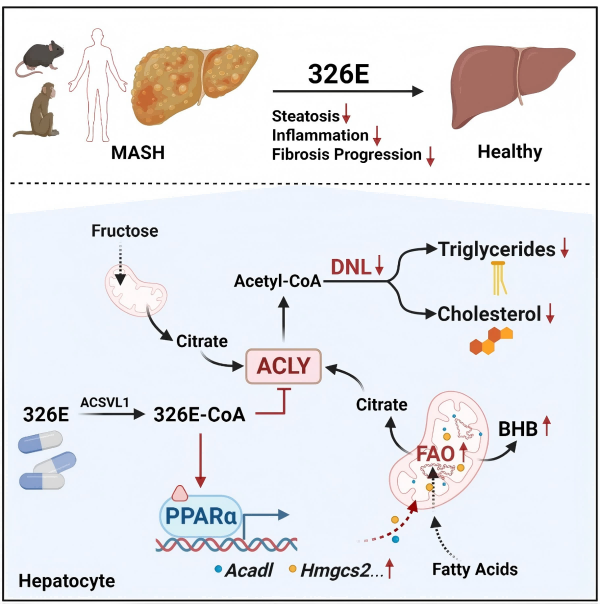Researchers Reveal Dual-Target Mechanism of New Drug BGT-002 for Treating Metabolic Dysfunction-Associated Steatohepatitis
Metabolic dysfunction-associated steatohepatitis (MASH) has become the fastest-growing cause of hepatocellular carcinoma. The disease is driven by insulin resistance, lipid accumulation, and inflammation in the liver. Despite its growing prevalence, effective treatments are still very limited. Until now, only resmetirom and semaglutide have been approved by the U.S. FDA, highlighting the urgent need for new therapies that can address the complex metabolic changes behind MASH.
In a study published in Cell Metabolism, a research team led by LI Jingya, NAN Fajun from the Shanghai Institute of Materia Medica of the Chinese Academy of Sciences, in collaboration with DING Yanhua from Jilin University and other partners, reported new findings on a potential treatment for MASH. The team discovered that 326E (also known as BGT-002), an enedioic acid analogue they developed, targets both ATP-citrate lyase (ACLY) and peroxisome proliferator-activated receptor alpha (PPARα) to restore hepatic lipid balance and alleviate MASH pathology.
The researchers found that ACLY, a key enzyme in de novo lipogenesis, is highly expressed in MASH patient livers and correlates with disease severity. In rodent and nonhuman primate models, 326E treatment markedly improved steatosis, inflammation, and fibrosis. A phase Ib/IIa randomized, double-blind, placebo-controlled trial (NCT06491576) further confirmed its translational potential. Daily oral administration showed good pharmacokinetics (half-life 85-101 hours) and tolerability. After 28 days treatment, patients exhibited reduced alanine aminotransferase (ALT), γ-glutamyltransferase (γ-GGT), and high-sensitivity C-reactive protein (hs-CRP) levels.
Mechanistic studies demonstrated that intracellular 326E-CoA, formed by ACSVL1-mediated activation specific in liver, competitively binds the CoA pocket of ACLY to inhibit lipid synthesis. Simultaneously, it engages the ligand-binding domain of PPARα through a noncanonical interaction, activating genes involved in fatty acid oxidation and mitochondrial function. Further, they identified that this dual-target synergy prevents the compensatory lipogenesis often induced by single PPARα agonists, resulting in coordinated metabolic improvement.
Overall, the study identifies BGT-002 (326E) as an ACLY/PPARα dual regulator, offering a promising potential therapeutic approach for MASH and metabolic liver diseases.
Link: https://doi.org/10.1016/j.cmet.2025.09.011
Key words: MASH, ACLY inhibitor, PPARα agonist

326E (also known as BGT-002), originally developed for hypercholesterolemia, shows previously unrecognized potential to safely treat MASH by simultaneously inhibiting ACLY and activating PPARα, as demonstrated from cell studies to a phase Ib/IIa clinical trial (NCT06491576). (Image by LI Jingya)
Contact:
DIAO Wentong
Shanghai Institute of Materia Medica
E-mail: diaowentong@simm.ac.cn




